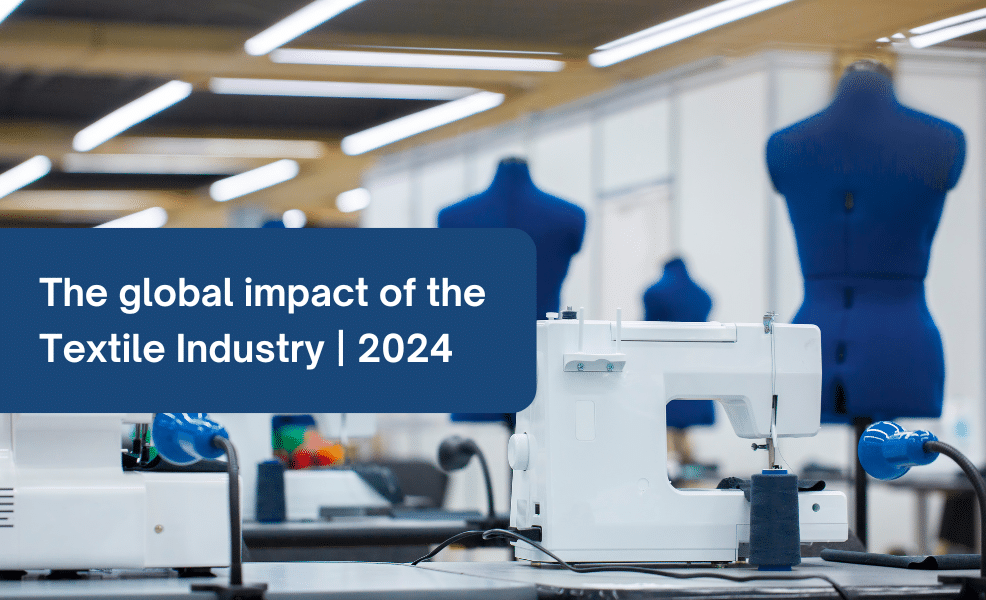Several large-scale global events have shaped the textile industry in the last decade or so. These include wars, recessions, inflation, global warming, and power shifts among countries.
Similarly, the textile industry has one of the biggest impacts on our daily lives. Due to this, it has become a key player on the global stage, which affects the flow of the economy. In this continuously expanding market, pivotal contributors include China, Europe, the USA, India, Bangladesh, and Pakistan.
Economic Impact of the Textile Industry
The economic impact of textiles extends far beyond profits, shaping industries, and livelihoods on a global scale.
- Contribution to global GDP
The textile industry market reached a valuation of USD 1,837.27 billion in 2023. Moreover, projections indicate a compound annual growth rate (CAGR) of 7.4% from 2024 to 2030.
Thus, when it comes to contribution to the global economy, the industry takes up 2% of the global GDP. It is also important to note that the top producers and exporters of textiles in the world contribute even more to global GDP.
- Employment generation
One of the biggest influences of the textile industry is the number of jobs it creates. On a global scale, the textile apparel industry generates jobs for 70 million people. More than two-thirds of these jobs are in Asia. In addition, 46.5 million jobs are in the manufacturing sector, which is about 66.5% of all textile jobs.
- Trade dynamics and globalization
With increasing globalization, the textile industry is undergoing a significant evolution. The regulations of the World Trade Organization (WTO) directly affect the textile supply chain. Free trade agreements, farm legislation, and other governmental decisions also have visible consequences in the industry. However, these effects are oftentimes unpredictable.
Environmental Impact
A subject that is swiftly gaining momentum in the textile industry is its impact on the environment and climate.
- Resource consumption
Textile industry practices utilize a large amount of resources. As the World Resources Institute reports, producing one cotton shirt required 2700 liters of water. This is enough for the drinking requirements of a person for two and a half years.
- Pollution
Textile production is the cause for about 20% of the pollution in our water. This happens because the colors and chemicals they use in making clothes can contaminate water bodies. According to European Parliament, one laundry cycle with polyester clothing can lead to the discharge of 700,000 microplastic fibres. These fibres can then contaminate the food chain.
- Waste generation
Fast fashion results in people throwing away clothes to buy new ones. When clothes end up in garbage, it accumulates as waste. The time it takes for clothing to decompose in the landfill can be more than 200 years.
Not only this, decomposition process of textiles can release greenhouse methane gas in the atmosphere. Additionally, it can also lead to leaching toxic chemicals and dyes into groundwater and soil in which we grow our food.
- Sustainable practices and initiatives
With the rising criticism from environmentalists, the textile industry is moving towards sustainability. These essentially include environment-friendly manufacturing process. It means that all materials and procedures, from inputs to outputs will not endanger the health and safety of people and the environment.
Due to this, many brands are now launching initiatives toward producing apparel through recycling. This is helping reduce the negative impacts of textile industry on the environment.
Social Impact
Textiles not only shape economies but also influence societies, leaving a lasting imprint on communities globally.
- Cultural implications and heritage preservation
Textile industry holds a lot of cultural importance. This is so because textiles represent the traditions and heritage of different groups. Traditional textiles often involve skilled craftsmanship passed down through generations, preserving historical stories and identity.
- Community development and empowerment
Textile hubs are vital for local economies, offering jobs and boosting growth. By supporting local businesses and creating employment, the industry helps communities prosper.
Future of The Textile Industry
The textile industry is changing with the help of new technologies and efforts to be more sustainable. This means brands in the industry are finding ways to manufacture products that are better for the environment. They are using recycled materials or natural fibers instead of ones that harm the planet.
They are also figuring out smarter ways to make clothes and fabrics, so they don’t waste as much resources or create as much pollution. As the industry adapts, it can grow while reducing its environmental footprint.

